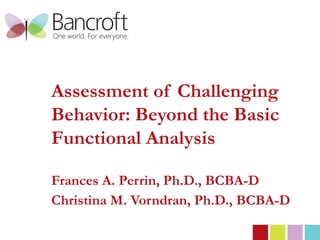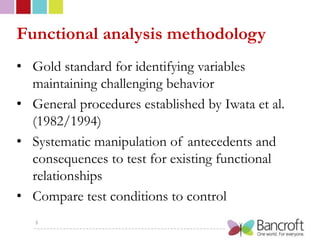Bancroft | Assessment of Challenging Behavior: Beyond the Basic Functional Analysis at Autism NJ
- 1. Assessment of Challenging Behavior: Beyond the Basic Functional Analysis Frances A. Perrin, Ph.D., BCBA-D Christina M. Vorndran, Ph.D., BCBA-D © 2012 | Bancroft All rights reserved.
- 2. Learning objectives Attendees will be able to identify: • how to use functional assessment data to develop procedural variations to the functional analysis conditions • several procedural variations for clarifying the results of an undifferentiated functional analysis • examples from the literature to support such procedural variations
- 3. Functional analysis methodology • Gold standard for identifying variables maintaining challenging behavior • General procedures established by Iwata et al. (1982/1994) • Systematic manipulation of antecedents and consequences to test for existing functional relationships • Compare test conditions to control 3
- 4. Functional analysis conditions • Positive reinforcement • Attention • Tangible • Negative reinforcement • Escape • Automatic reinforcement • Alone/No interaction • Control 4
- 5. Functional analysis results • Empirical demonstration of functional relationships • Sometimes results are not clear/complete • idiosyncratic variables • target behavior not observed • results do not match hypothesis • inconsistent/variable rates across all conditions - misinterpreted as automatic • function-based treatment ineffective 5
- 6. Clarifying inconsistent results • Research literature reports 5% inconclusive results with FA • Methodological modifications • Antecedent variables • Consequence variables • Other 6
- 7. Clarifying inconsistent results • Use existing functional assessment data • Collect additional data in natural environment • Interviews • Observations • Select modification and make sure to establish an appropriate control condition 7
- 9. Manipulating antecedents • Use results of FBA to inform variations • Each condition can be modified • Discriminative stimuli • Motivating operations • Additional assessments may be conducted prior to conducting an FA or following an FA with inconsistent results 9
- 10. Demand assessment Smith, Iwata, Goh, & Shore (1995) • Novelty – compared the reinforcing effects of escape from familiar vs unfamiliar tasks • Duration – 15 minute sessions; looked at within session trends in challenging behavior • Rate – compared high (30 trials) vs low (10 trials) rate conditions • Additional assessment helped to identify the specific dimension of demand responsible for the escape function for 89% of the participants 10
- 11. Demand assessment Roscoe, Rooker, Pence, & Longworth (2009) • Assessed 12 different tasks per participant • Identified high-p and low-p demands • Compared both types in a standard multielement FA • Differentially higher rates of challenging behavior were observed in the low-p condition for all participants 11
- 12. Example of a need for additional assessment 5 4.5 Agg, Dis, SIB per Minute 4 3.5 Alone 3 Social Attention Toy Play 2.5 Demand 2 Tangible 1.5 1 0.5 0 1 5 9 13 17 21 25 29 Session 12
- 13. Type of task 3 Academics Agg, Dis, SIB per Minute 2.5 2 1.5 Vocational 1 0.5 Toy Play 0 1 2 3 4 5 6 7 8 9 10 11 12 13 14 15 16 Session 13
- 14. Verbal prompts vs no prompts 22 20 18 16 Aggression Per Minute 14 Prompts 12 10 8 Demand 6 4 Tangible No prompts 2 0 2 4 6 8 10 12 14 16 18 20 22 24 26 28 30 32 34 36 38 40 42 Session 14
- 15. Attention assessment Roantree & Kennedy (2006) • Evaluated whether attention functioned as an EO or AO • Compared results of multielement FAs • EO test - 4 sessions (1 each condition) per day preceded by 20 min of attention • AO test – 4 sessions (1 each condition) per day preceded by no attention 15
- 16. Roantree & Kennedy (2006) 16
- 17. Example of a need for additional assessment 12 Aggression + Disruption per minute 10 8 Attention Toy Play 6 Demand Tangible 4 2 0 1 2 3 4 5 6 7 8 9 10 11 12 13 14 15 16 17 18 19 20 21 22 23 24 25 26 27 28 Session 17
- 18. Divided attention 1.6 1.4 Aggression/Disruption per Minute 1.2 1 Divided 0.8 0.6 0.4 Control 0.2 0 1 2 3 4 5 6 7 8 9 10 11 12 13 14 15 16 Session 18
- 19. Removal of tangible from view 4.0 Tangible items out of room 3.5 3.0 Disruptions per minute 2.5 Tangible 2.0 1.5 1.0 0.5 0.0 1 2 3 4 5 6 7 8 9 10 11 12 13 14 15 16 17 18 19 20 21 22 23 24 25 26 27 Session 19
- 20. Other antecedent manipulations • Combined MOs • Call, Wacker, Ringdahl, & Boelter (2005) • Specific or consistent Sds associated with each condition (e.g., therapists, stimuli, colors) • Conners et al. (2000) • Idiosyncratic antecedents that evoke behavior (e.g., trigger words) 20
- 21. Call et al. (2005) 21
- 22. Conners et al. (2000) 22
- 23. Consistent therapists 5 Consistent therapists in demand and attention 4 Aggression per minute 3 Attention Toy play Demand 2 Alone 1 0 1 3 5 7 9 11 13 15 17 19 21 23 25 27 29 31 33 35 37 39 41 43 45 47 49 51 53 55 Session 23
- 24. Trigger word “No” 2 1.8 Agg, Dis, SIB, and Scream per Minute 1.6 1.4 1.2 1 "No" Condition 0.8 0.6 0.4 Toy Play 0.2 0 1 2 3 4 5 6 7 8 Session 24
- 26. Manipulating consequences • Use results of FBA to inform variations • Qualitative differences of the reinforcer • Attention –(e.g., Kodak, Northup, & Kelley, 2007) • Tangible – (e.g., Reed, Pace, & Luiselli, 2009) • Escape – (Golanka et al., 2000) 26
- 27. Kodak, Northup, & Kelley (2007) 27
- 28. Quality of attention 3 2.5 Mouthing per minute 2 Brief Reprimand Enthusiastic Attention 1.5 1 0.5 Toy Play 0 1 2 3 4 5 6 7 8 9 10 11 12 13 14 15 16 17 18 19 20 21 Session 28
- 29. Reed, Pace & Luiselli (2009) 29
- 30. Golonka et al. (2000) • Evaluated response allocation to two break options for 2 individuals whose behavior was known to be maintained by escape • Break alone vs break with attention and enriched environment • Results indicated that the enriched break option was associated with an increase in choice making and compliance • Implications for modifying a functional analysis 30
- 32. Other variations • Extended alone • Antecedent (AB) only • Hypothesis testing via pairwise • Trial-based 32
- 33. Vollmer, Marcus, Ringdahl, & Roane (1995) • Evaluated the effects of a methodology for progressing from brief to extended FA to clarify undifferentiated results • Proposed extended alone condition as a method for ruling out an automatic function • If behavior persists automatic • If behavior extinguishes likely socially maintained 33
- 34. Is it automatic? 7 Multi-element Extended Alone 6 Number of Perseverations 5 Control 4 Attention Tangible 3 Alone Escape 2 1 0 1 3 5 7 9 11 13 15 17 19 21 23 25 27 29 31 33 35 37 39 41 43 45 47 Session 34
- 35. Antecedent only (AB) method • Procedures introduced by Carr & Durand (1985) • Systematically manipulate difficulty of demands and levels of attention • Between 1994-2000, approximately 20% of studies reported in the literature used this methodology to conduct a functional analysis 35
- 36. Limitations of AB method • Programmed consequences for the challenging behavior do not include functional reinforcer • Functional relationships are not demonstrated • Cannot be used for automatic reinforcement because no control condition
- 37. Pairwise design • Test vs control conditions • Based on results from indirect and other direct assessment • Conduct only the conditions necessary to confirm the hypothesis – saves time
- 38. Trial-based method Bloom, Iwata, Fritz, Roscoe, & Carreau (2011) • Evaluated a trial-based approach to FA in a classroom setting • Trials consisted of three 2 min segments of control – test – control • If target behavior occurred within the 2 min test condition, it was reinforced and trial was ended 38
- 39. Bloom et al. (2011) Results showed: Correspondence of function identified for 6 of 10 participants. Partial correspondence for 1 of the remaining 4 participants. No correspondence for 3 participants. 39
- 40. Conclusions 40
- 41. Benefits of FA • FA identifies functional relationships between the antecedents, consequences, and target behavior • Allows for the development of interventions that target the maintaining variables • As more specific reinforcement-based procedures have been implemented based on results of FAs • Decreased need for default treatments • Decreased need for punishment procedures
- 42. A challenge of FA • Inconsistent results •Standard conditions are not be sufficient at producing differentiated results for every individual with challenging behavior •Extensions of methodology allow for identification of specific variables maintaining challenging behavior
- 43. Best practices • Choosing the approach to the functional analysis •Inconclusive results from standard methodology leads to variations in conditions based on information collected through direct observation •In depth analysis of direct observation data prior to FA leads to variations in conditions or pre-assessment 43
- 44. Conclusions • Functional analysis methodology continues to be the gold standard for identifying variables maintaining challenging behavior • Systematic manipulation of antecedents and consequences to test for existing functional relationships is necessary when initial results are inconsistent • There is still room for additional changes to improve efficiency and generality
- 45. Questions? For a copy of this presentation please email Dr. Vorndran at Christina.vorndran@bancroft.org


















































































